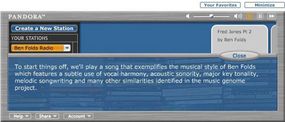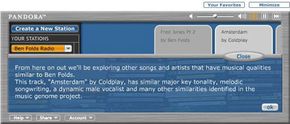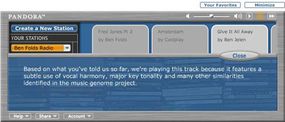When it comes to finding new music for your library, there are a lot of ways you can go. You can spend hours combing Web sites for new artists and listening to clips. You can frequent music blogs or message boards. You can trust the Amazon-type "people who bought this also bought" recommendations or listen to radio stations and podcasts waiting to hear something new and appealing. You can scan the music libraries of friends who actually enjoy doing the music-finding legwork.
With the advent of Web-based "music-discovery services," though, the art of finding new music has changed. Internet radio sites like TagWorld, Last.fm and Pandora let you type in a song or artist you like and instantly find other music that might fit your taste. But while Pandora provides a similar service to Last.fm and TagWorld, it actually works very differently. Starting with the British band Gomez as the initial input, the first several "matches" from Last.fm include the Doves, Badly Drawn Boy and Radiohead. TagWorld returns songs by R.E.M., Badly Drawn Boy and Radiohead. Pandora delivers Cheap Trick, Modest Mouse and The Vines. The difference is the Music Genome Project.
Advertisement
Pandora has no concept of genre, user connections or ratings. It doesn't care what other people who like Gomez also like. When you create a radio station on Pandora, it uses a pretty radical approach to delivering your personalized selections: Having analyzed the musical structures present in the songs you like, it plays other songs that possess similar musical traits.
Pandora relies on a Music Genome that consists of 400 musical attributes covering the qualities of melody, harmony, rhythm, form, composition and lyrics. It's a project that began in January 2000 and took 30 experts in music theory five years to complete. The Genome is based on an intricate analysis by actual humans (about 20 to 30 minutes per four-minute song) of the music of 10,000 artists from the past 100 years. The analysis of new music continues every day since Pandora's online launch in August 2005. As of May 2006, the Genome's music library contains 400,000 analyzed songs from 20,000 contemporary artists. You won't find Latin or classical yet: Pandora is in the process of developing a specialized Latin music Genome and is still deep in thought about how to approach the world of classical composition.
When you arrive at Pandora.com, the first thing you see is the player, which is pretty sweet. It's Web-based (no download), minimalist and seamless.
Pandora.com is our interface with the Music Genome Project database. All you do to get started is type a song or artist into the main field of the player. If we type in, say, "Ben Folds" and click the "create" button, we've created a radio station called "Ben Folds Radio" that will only play songs with similar musical traits to Ben Folds' songs.

In the next section, we'll look at how Pandora uses the musical traits of a song.
Advertisement






